Reign
When Venkata Rao died in 1861, 14-year old Shivashanmukha Rao ascended the throne. As he was yet a minor, the administration was handled by a regency. Shivashanmukha Rao did not have a full formal coronation till 1863, when his sanad was renewed by the Madras government. In 1876, he was accorded the title of "Raja" by the British.
As soon as he assumed the throne in 1863, Shivashanmukha Rao selected J. Macartney, a missionary of the LMS as his agent and advisor. During his tenure, Macartney introduced many reforms and improved the administration of the state. Macartney retired in 1885 and was succeeded by J. G. Firth, a former tahsildar of Bellary.
Venkata Rao was a recipient of the Prince of Wales medal (1876). In 1877, was awarded a Kaisar-i-Hind Medal on the occasion of the Delhi Durbar.
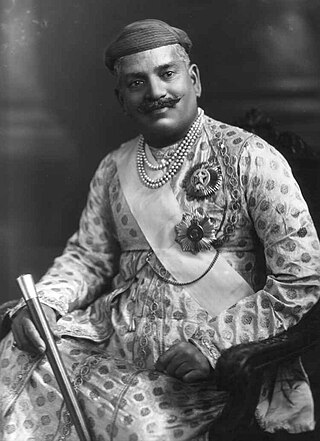
Sayajirao Gaekwad III was the Maharaja of Baroda State from 1875 to 1939, and is remembered for reforming much of his state during his rule. He belonged to the royal Gaekwad dynasty of the Marathas which ruled parts of present-day Gujarat.

Sandur State was a princely state of India during the British Raj, part of the Madras States Agency. Its capital was the town of Sanduru.
Raja Sri Ravu SvetachalapatiSir Ramakrishna Ranga RaoKCIE was an Indian politician and zamindar who served as the First Minister of Madras Presidency from 5 November 1932 to 4 April 1936 and 24 August 1936 to 1 April 1937.

Sir Sri Ayilyam Thirunal Rama Varma IVGCSI CIE (1832–1880) reigned as Maharaja of Travancore from 1860 to 1880. His reign was highly successful, with Travancore, gaining the appellation of "model state of India", with such celebrated administrators as Raja Sir T. Madhava Rao and Sir A. Seshayya Sastri serving him as Diwans.

The Kingdom of Amber, also known as Kingdom of Dhundhar, and Jaipur State, was located in the north-eastern historic Dhundhar region of Rajputana and was ruled by the Kachwaha Rajput clan. It was established by Dulha Rai, possibly the last ruler of the Kachchhapaghata dynasty of Gwalior who migrated to Dausa and started his kingdom there with the support of Chahamanas of Shakambhari in the 12th century. Mostly through 12th to 15th century, the kingdom faced stagnation, sources were scarce. Under its ruler, Raja Chandrasen of Amber became a Sisodia vassal and fought in the Battle of Khanwa under Raja Prithviraj Kachhwaha.

Shrimant Maharaja Sir Pratap Singh Rao Gaekwad, who belonged to the Gaekwad dynasty of the Marathas, was the ruling Maharaja of Baroda. He succeeded to the throne upon the death of his grandfather Sayajirao Gaekwad III in 1939. In 1947, British India was partitioned into two independent dominions, and Pratap Singh acceded his state to the Dominion of India. By 1949, Baroda had been merged into India.
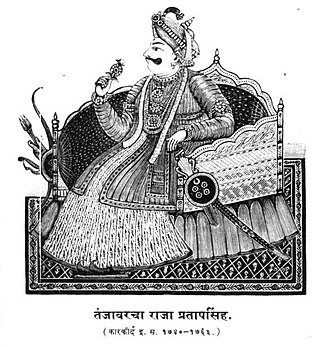
Pratap Singh Bhonsle or Pratapsinha was the Maratha ruler of Thanjavur of the Bhonsle dynasty from 1739 to 1763. His rise to power followed three years of anarchy and civil war and restored the state to its previous greatness. His reign witnessed the Carnatic Wars and the Seven Years' War.
Raja Sir Harnam Singh Ahluwalia , KCIE was a member of the Kapurthala royal family in the direct line founded by Jassa Singh Ahluwalia.
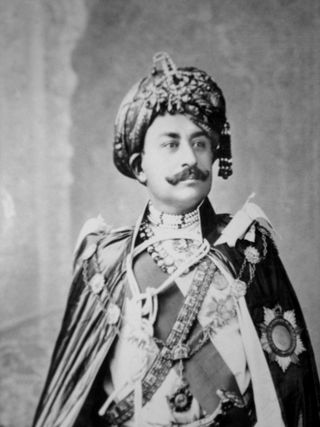
Maharajadhiraj Mirza Maharao Sir Khengarji III Sawai Bahadur was a progressive and one of the longest ruling monarchs and also the longest ruling king of the Princely State of Kutch from 1875 to 1942.
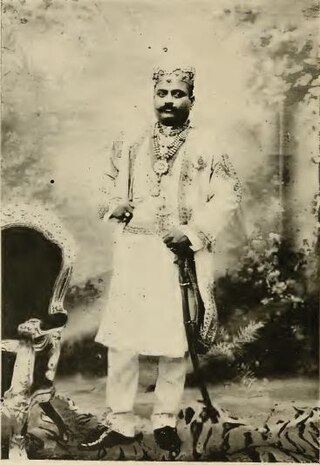
Sir Sri Venkata Svetachalapathi Venkatesh Srinivasa Ranga Rao Bahadur was an Indian landlord, maharaja, polygar,and zamindar of Bobbili in Madras Presidency; List of zamindari estates in Madras Presidency;from 1881 to 1921. His grandson and successor Raja Sir Sri RAMAKRISHNA SVETA CHALAPATI Ranga Rao Bahadur, K.C.I.E. served as the Chief Minister of Madras Presidency from 1932 to 1936.
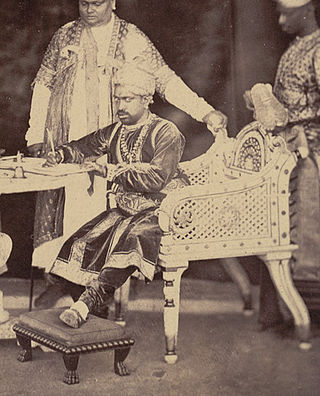
Raja Sri Brahdamba Dasa Raja Ramachandra Tondaiman Bahadur was the ruler of princely state of Pudukkottai from 13 July 1839 to 15 April 1886.

Bundi State, founded by Hada Rao Devda, was a princely state in India. The former state was located in modern-day Rajasthan. It was ruled by Hada Chauhan Rajputs.
Murarirao Yeshwantrao Ghorpade was an Indian politician. He was the son of the last Raja of the Sandur State, a former Princely State. He was a former MLA from Sandur and one-time MP from Raichur, Karnataka. He also served as Minister for Rural Development, Panchayat Raj and Finance in the Karnataka State Government. Ghorpade was the Chairman-emeritus of Sandur Manganese and Iron Ore Pvt. Ltd. (SMIORE). He held a Master's Degree in Economics from the University of Cambridge.
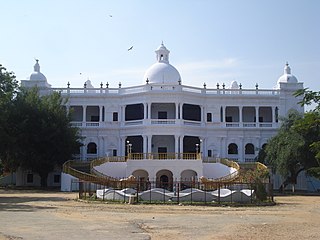
Wanaparthy Samsthanam or Raja of Wanaparthy was a vassal of the Nizam of Hyderabad. He controlled the feudatory of Wanaparthy. It was one of the three important samsthanams in Telangana, the other two being Gadwal Samsthanam and Jatprole Samsthanam.
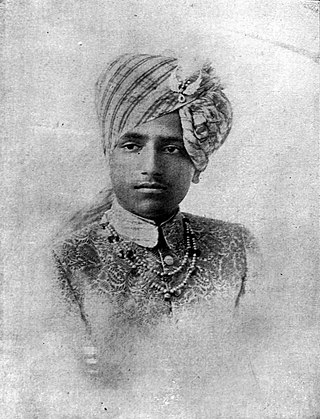
Maharaja Srimant Yeshwantrao Hindurao Ghorpade was the ruler of the princely state of Sandur from 1928 to 1949. He was the last Rajah of Sandur and presided over the accession of the state to the Dominion of India. He was also an ardent wildlife conservationist and member of the Bombay Natural History Society.

Raja Shrimant Venkatarao Ramchandrarao Ghorpade was the ruler of the princely state of Sandur from 1892 to 1927. The state was administered by a council of regency till 1913 when he was invested with full ruling powers. Venkata Rao was a recipient of the 1903 Delhi Durbar and 1911 Delhi Durbar medals. On his death in 1927 and in the absence of a male heir, Venkata Rao was succeeded as ruler by his cousin Yeshwantrao Ghorpade.
Raja Srimant Ramachandrarao Vitthala Rao GhorpadeCIE was a member of the Ghorpade Dynasty who served as the Maharaja of the princely state of Sandur from 1878 to 1892.
Siva Rao was a member of the Ghorpade Dynasty who served as the ruler of Sandur from 1796 to 1817 and 1818 to 1840. In 1799, Siva Rao signed as treaty of Subsidiary Alliance with the East India Company.
Ghorpade is a surname and family name found among Marathas, Marathi Brahmins, Mahar and even Chambhar caste in the Indian states of Maharashtra and Karnataka and may refer to members of the Ghorpade Dynasty.
This page is based on this
Wikipedia article Text is available under the
CC BY-SA 4.0 license; additional terms may apply.
Images, videos and audio are available under their respective licenses.












